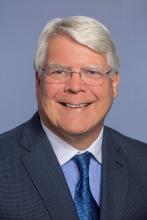‘A dark, dark place’
As the lawsuit dragged on, Dr. Matt Seaman’s mental health deteriorated. Bouts of depression had emerged before. Two job transitions over the years had triggered depression, his wife recalled. Both times, Dr. Seaman had improved with antidepressants prescribed by his family physician, she said.
In August 2018, Dr. Matt Seaman voluntarily entered an inpatient psychiatric unit after telling his family doctor that he felt suicidal. After the hospitalization, he was assigned a telemedicine psychiatrist and started sessions with a licensed mental health therapist.
But this time, he didn’t get better, his wife said. Antidepressants weren’t working. He was growing more despondent by the day, hardly sleeping, and losing weight. He spent Christmas day 2018 in the psychiatric unit during another inpatient stay that lasted nearly 3 weeks. In journal entries at the time, Dr. Seaman wrote about his family coming to visit and how much he loved them, but he noted that he was worried about the stressors that awaited at home.
“I am not well enough for discharge,” he wrote. “I am still mentally ill. It will still require months of agony before the depression fades. And I’ll have lots of stressors to hold me back. ... I am discouraged about not being well ... but it’s time to leave this place.”
As she watched her husband decline, Dr. Linda Seaman fervently tried to help him, researching, making calls, and taking steps to protect his safety at home. She believed that electroconvulsive therapy, transcranial magnetic stimulation, or IV ketamine might help, but she said his psychiatrist was unwilling to authorize the interventions.
The approaching deposition filled Dr. Matt Seaman with dread. Hoping the judge might delay the deposition, Dr. Linda Seaman twice asked whether his psychiatrist would write a letter to the court relaying Dr. Matt Seaman’s worsening mental condition. He would not, she said.
“I reiterated my concern, that if [Dr. Matt Seaman] was not able to endure this process and his depression continued to worsen with suicidal ideation, and he would not write him a letter of protection, then who would?” Dr. Linda Seaman recalled. “He referred me to his family doctor for such interventions.”
Joseph R. Doumit, MD, a Seattle-based telepsychiatrist with Virginia Mason Memorial hospital, did not return messages seeking comment. A spokeswoman for Virginia Mason Memorial said the hospital declined to comment.
On March 22, 2019, Dr. Matt Seaman attended a deposition preparation meeting with his defense attorney that lasted several hours. He returned home physically and emotionally exhausted. Concerned, Dr. Linda Seaman asked whether they should try to postpone the March 26 deposition.
“I just need this to be over,” Dr. Seaman told his wife, and then added, “Linda, I am in such a dark, dark place.”
An uphill road to care
The path to mental health care for physicians is strewn with hurdles, experts say. Doctors must first overcome the fears of judgment and discrimination, Dr. Zisook said. That sharing their condition may affect licensing or malpractice insurance are two common concerns.
“Stigma is real in general, and [feelings of] stigma are exacerbated when you’re depressed,” he said. “Physicians, instead of getting help or acknowledging when they’re depressed, [may] just try to sweep it under the cover.”
Physicians also face obstacles in finding mental health care and receiving effective treatment. Frequently, physicians avoid treating other doctors, and when they do, they cut corners and ignore red flags, said Peter Yellowlees, MD, a psychiatrist and chief wellness officer at the University of California, Davis Health.
“A lot of doctors don’t particularly like treating colleagues,” Dr. Yellowlees said in an interview. “They can be intimidating.”
, said Dr. Yellowlees, author of the book, “Physician Suicide: Cases and Commentaries” (American Psychiatric Association Publishing, 2019). The treating physician may make excuses not to confront the real diagnosis, he added.
Doctors often don’t keep as close an eye on physician patients as they should and fail to get them back as quickly as necessary for follow-up, Dr. Myers added. The problem is compounded by the fact that physician patients can require a different approach and closer inspection than nonphysicians, he noted.
“They may not appreciate that when a doctor becomes a patient, it can be tricky,” he said. “Because they have some medical knowledge, some doctors are used to putting on a front, and they’re actually hiding how ill they feel. When you look after a doctor, you have to be a little suspicious that they may be covering up their suicidality. There’s a real art to looking after seriously ill physicians, and the doctor looking after them has to really take charge.”

